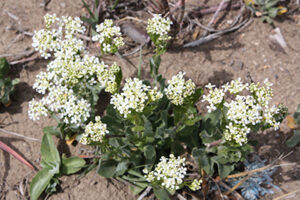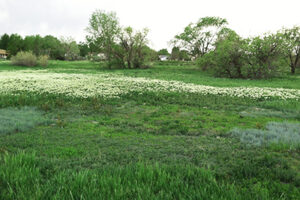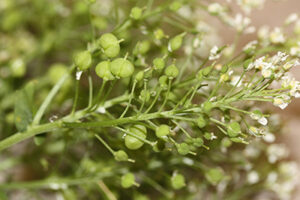Hoary cress
Cardaria draba
Other Names: Whitetop, Heart-podded whitetop
Hoary cress is a List B perennial. This member of the mustard family reproduces by seed and rhizomes and can quickly form a monoculture.
Plants can be up to about 18 to 24 inches tall but are generally smaller. The leaves are dark green. Lower leaves have a petiole but leaves higher on the plant clasp the stem. Dense clusters of four-petaled white flowers grow at the ends of upright branches. Seedpods are slightly inflated and heart-shaped. Each plant produces up to 4800 seeds per year.
Large patches can be seen along roadsides and in parks in early spring. Hoary cress is also an agricultural pest in rangeland, pastures and in crops such as wheat.
Hoary cress has been known in Colorado since 1898. There are also two other weedy whitetops known in the state. Lens-podded whitetop (Cardaria chalapensis) and Hairy whitetop (Cardaria pubescens).
What You Can Do
Talk to your local park manager and see if they would like help locating patches of noxious weeds.
If you have Hoary cress on your property, treat it before it blooms.
Tell your neighbors. We will all benefit when more people become aware of the problem and take action.
Prevention
Clean your gear and equipment when moving between different sites. Whether you are a hiker, biker or work outdoors, weeds can easily be moved unintentionally by clinging to your clothing and equipment. Learn more at PlayCleanGo.
Resources
Field Guide for Managing Whitetop in the Southwest



